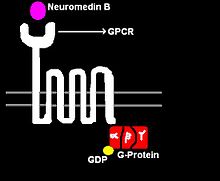Neuromedin B
| neuromedin B | |||||||
|---|---|---|---|---|---|---|---|
| Identifiers | |||||||
| Symbol | NMB | ||||||
Chr. 15 q11-qter | |||||||
| |||||||
Neuromedin B (NMB) is a bombesin-related peptide in mammals.[1][2] It was originally purified from pig spinal cord, and later shown to be present in human central nervous system and gastrointestinal tract.[3]
Sequence
The sequence of the C-terminal decapeptide is highly conserved across mammalian species: GNLWATGHFM-(NH2); this decapeptide is sometimes noted as neuromedin B, but it is more accurately described as neuromedin B 23-32. The sequence of neuromedin B (in rat) is: TPFSWDLPEPRSRASKIRVHPRGNLWATGHFM-(NH2).[4] The (NH2) here indicates a post-translational modification -- alpha amidation of the carboxy terminus.
Function


Neuromedin regulates the following functions:
- exocrine and endocrine secretions
- cell growth
- body temperature
- blood pressure and glucose level
- sneezing[5]
Neuromedin signaling pathway
NMB acts by binding to its high affinity cell surface receptor, neuromedin B receptor (NMBR). This receptor is a G protein-coupled receptor with seven transmembrane spanning regions, hence the receptor is also denoted as a 7-transmembrane receptor (7-TMR). Upon binding several intracellular signaling pathways are triggered (see Figure 2).
When NMB binds to its 7-TMR, the
References
External links
- Neuromedin+B at the U.S. National Library of Medicine Medical Subject Headings (MeSH)
